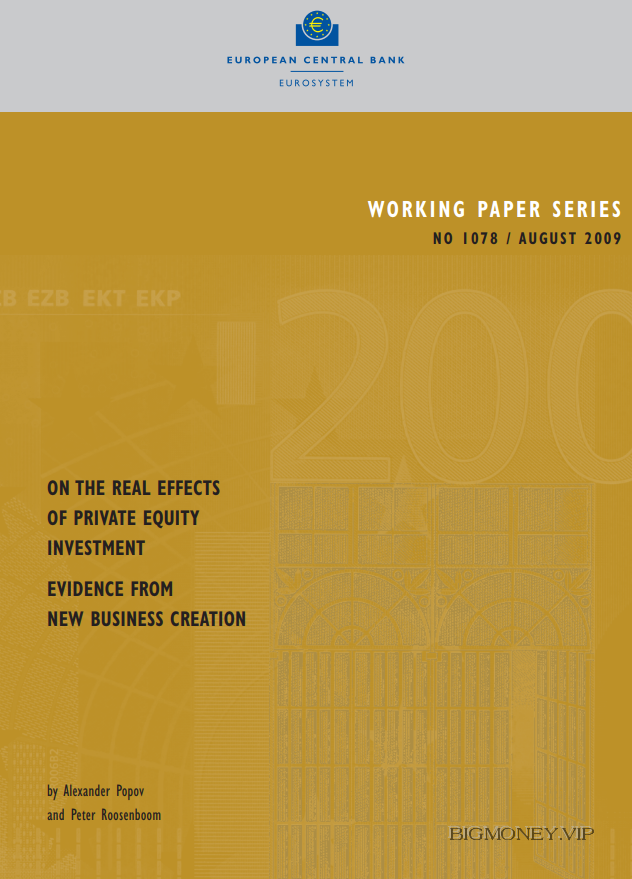On the Real Effects of Private Equity Investment Evidence from New Business Creation by Alexander Popov and Peter Roosenboom

1 Introduction
It is generally accepted that access to credit is an important determinant of Örm entry and
growth (Rajan and Zingales (1998)). However, banks are often reluctant to Önance small
new Örms because of high uncertainty, information asymmetry, and agency costs (Beck et al.
(2005)). Private equity investors are specialized to overcome these problems through the use
of staged Önancing, private contracting, and active monitoring (Hellmann (1998); Gompers
and Lerner (1999, 2001a); Kaplan and Stromberg (2001)) and are therefore more likely to
Önance early stage and technology companies than banks. In this paper, we investigate
the previously unexplored e§ect that these private equity investments have on new business
creation in Europe. This question is highly relevant to policy makers given that they often
perceive venture capital as an important contributor to the rising leadership of US Örms
in high technology industries (Gompers and Lerner (2001b)). Hoping to rival this success,
the European Union stimulates venture capital investment in an attempt to make Europe
a hotbed for entrepreneurship (Aernoudt (1999); Gilson (2003)). This paper puts the idea
that venture capital fosters new business creation to the test.
Our study makes two key contributions to the literature. First, although there is a large
body of empirical literature looking at the e§ect of Önance on Örm entry, the vast majority
of it has studied the impact of developments in the banking sector on business formation,
with mixed results. Petersen and Rajan (1995) show that Önancial liberalization hurts small
young companies because creditors in competitive credit markets Önd it more di¢ cult to
internalize the beneÖts of assisting those Örms. However, Black and Strahan (2002) Önd
evidence that the rate of incorporation increases as a result of banking deregulation, and in
a related paper Cetorelli and Strahan (2006) use a measure of bank deregulation to show how
average Örm size in an industry decreases with bank competition, arguably due to increased
entry rates. Regarding general credit market development, Aghion et al. (2007) Önd that
deeper and more developed banking sectors are associated with higher entry of small Örms
in sectors which are more dependent on external Önance. While the e§ect of banking sector
development and restructuring on small business formation is certainly important, the e§ect
of private equity investment, especially start-up Önance, is probably equally important and
largely understudied. This paper aims to Öll this gap.
The second contribution is that we add to a remarkably limited research on the e§ects
of private equity on the real economy. Kortum and Lerner (2000) show that venture capital
investment in the United States is associated with more innovation as measured by patent
counts and patent citations. Gompers et al. (2005) examine the propensity of publicly traded
Örms to create new venture backed Örms. They Önd that younger public Örms located in
main hubs of venture capital activity are the most likely to create new ventures. Tang and
Chyi (2008) Önd that venture capital investment enhances productivity growth. Regarding
new business formation, we are only aware of one study that examines the impact of venture
capital at the regional level in the U.S. Mollica and Zingales (2007) report that Örm entry
and innovation increase in U.S. regions that attract more venture capital. Our paper adds
to this literature by providing the Örst comprehensive cross-country study examining the
e§ect of private equity on Örm entry in Europe. Moreover, our European data enables us
to distinguish between stages and investor types and does not focus on the e§ect of venture
capital alone but also includes the e§ects of later stage private equity, like buyout Önance.
There are two main mechanisms suggested by the literature via which private equity in
general and venture capital in particular should lead to higher rates of business incorpo-
ration. First, nascent entrepreneurs may recognize the need for capital in the future and
only establish Örms when they have reasonably high expectations of obtaining such funding.
This implies that not just start-up Önance, but later Önancing stages, like expansion Önance,
should matter too for Örm entry. Second, Örms may be engaged in "entrepreneurial spawn-
ing", that is, the propensity of former employees of publicly traded Örms to start their own
companies. There are several competing explanations for that. Christensen (1997) has ar-
gued that large, established Örms are incapable of adopting radical new technologies because
it would disrupt their established way of organizing business. It is also possible that these
Örms cannot evaluate new disruptive technologies as they fall outside of their line of business




